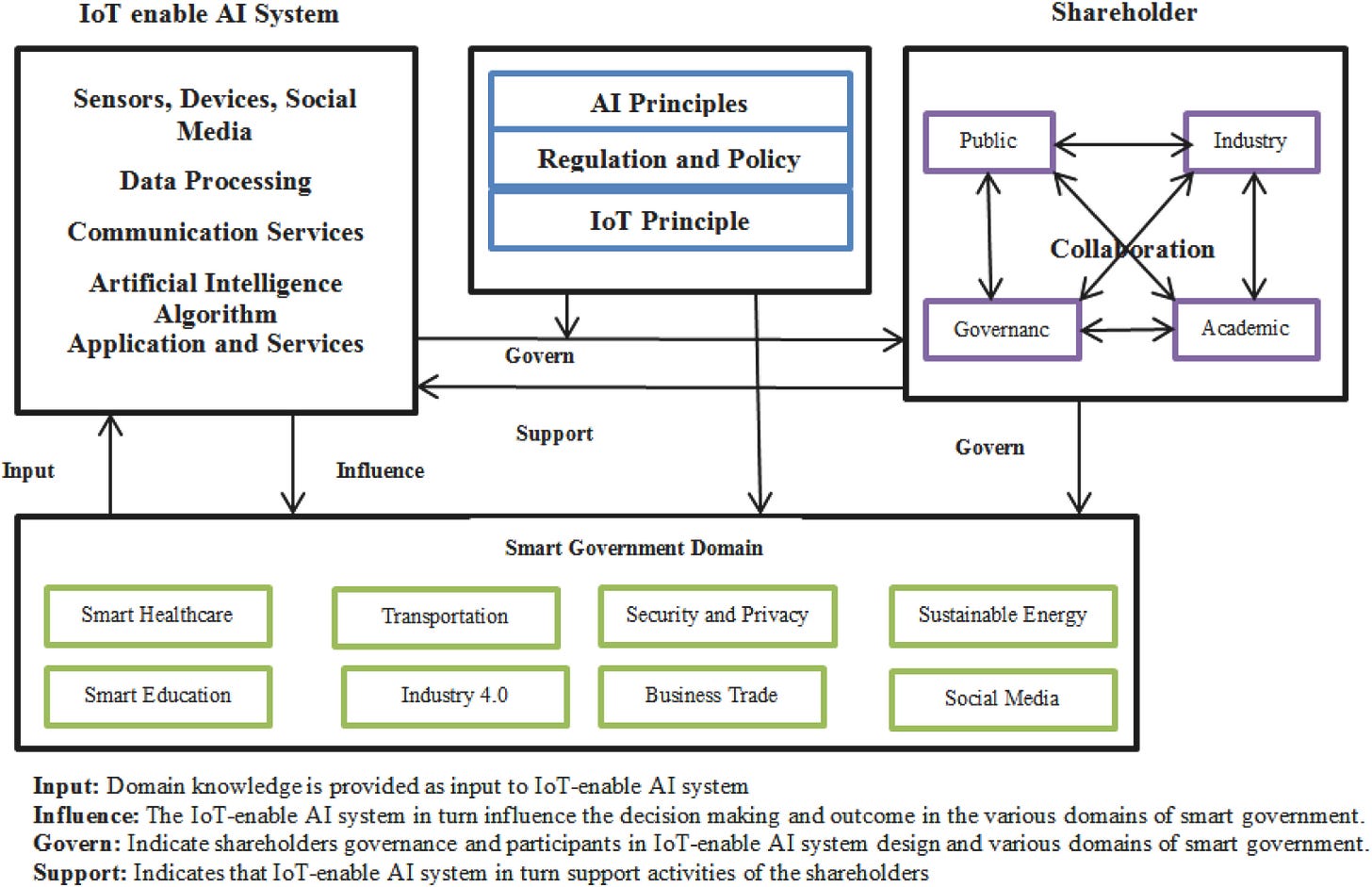The New Sovereignty: Why Owning Your AI Models Matters for National Security
How full ownership of AI models is becoming the foundation of modern statecraft
In an increasingly complex and contested world, sovereignty is being redefined. It is no longer measured solely by territorial integrity or military might - but by the ability to govern, interpret, and act upon data. Nowhere is this more evident than in the geospatial domain, where artificial intelligence (AI) has become essential for national decision-making. Governments around the world are investing in geospatial AI to enhance situational awareness, automate intelligence workflows, and enable predictive planning. For governments, owning the AI models that process and interpret geospatial data is not merely a matter of technical preference; it is a matter of national security.
Geospatial AI: A Strategic Capability
From surveillance and reconnaissance to infrastructure monitoring, climate resilience, and emergency response, geospatial intelligence underpins a wide array of governmental functions. AI amplifies this capability - enabling vast volumes of satellite, drone, and sensor data to be interpreted in near real time, identifying patterns and anomalies that human analysts alone cannot process at scale.
The integration of AI into geospatial operations allows governments to move from reactive to proactive decision-making. But this intelligence is only sovereign when the underlying models and not just the data are governed, secured, and maintained under national authority.
Government Ownership Of AI Models
Owning the geospatial data is only part of the equation. Governments must also own the models that generate insight from this data. This includes the algorithms, trained weights, documentation, update pipelines, and system integrations. Ownership enables:
1. Full Operational Control
Governments can operate models without dependence on external providers. In the event of a geopolitical crisis, cyberattack, or supply chain disruption, sovereign operations remain unaffected. Models can be deployed in secure environments, disconnected from the internet if needed.
2. Customisation To National Context
Ownership allows for ongoing training and fine-tuning based on local terrain, sensor types, and strategic requirements. A sovereign model can evolve with national priorities, whether focused on urban security, maritime patrol, or environmental forecasting.
3. Auditability and Transparency
Government-owned models can be audited for biases, vulnerabilities, and performance characteristics. It becomes possible to easily explain when the architecture and training history are fully accessible.
4. Lifecycle Autonomy
Ownership ensures models can be maintained, updated, and retired on government timelines - not vendor release cycles. Governments can scale capabilities, manage versioning, and maintain readiness without external dependency.
True Ownership of Models vs Licensing
Many AI procurements today focus on service-level agreements or software licenses, granting access to hosted models rather than true ownership. While this approach may offer convenience, it falls short of sovereignty. For functions relating to national security, critical infrastructure, and emergency response, this model-access approach is increasingly inadequate.
Licensing typically grants permission to use a proprietary model, hosted by the vendor or on third-party cloud infrastructure, under specified terms and conditions. The government may be allowed to input data and receive outputs, but it does not control the underlying architecture, training data lineage, update schedules, or performance thresholds. True ownership allows the government to hold:
Access and modify source code, architecture, and hyperparameters
Retrain or fine-tune the model using local or updated datasets
Host and deploy the model within sovereign infrastructure, whether online, air-gapped, or embedded in edge systems
Integrate the model into national platforms without restriction
Audit and certify the model against national standards for performance, explainability, and security
The Strategic Implications of Non-Ownership
Failure to own critical AI models may lead to:
Operational dependency on other firms.
Data exposure risks, especially when inference or retraining occurs offsite.
Reduced agility in adapting to emerging threats or operational demands.
Limited assurance in model performance, bias mitigation, or legal compliance.
Vulnerability to supply chain disruption - including software updates, license expirations, or contractual disputes.
Framework For Model Ownership
To operationalize sovereignty in geospatial AI, governments should develop a formal Model Ownership Strategy as part of their broader digital defense posture. Key components include:
Assessment frameworks to evaluate the criticality of each AI model.
Procurement standards that define ownership terms and handover requirements.
Model assurance protocols for performance testing, adversarial robustness, and explainability.
National model registries to track provenance, versioning, and deployment history.
Talent development programs to grow the internal capability to manage, adapt, and evolve models post-deployment.
Why a Secure Platform Is Essential
Owning AI models is the foundation, but a secure, scalable, and sovereign platform is the engine that brings them to life.
Governments require a platform not only to run these models, but also to:
Centrally manage multiple AI models across agencies, domains, and missions
Continuously monitor performance, integrity, and compliance
Securely handle sensitive geospatial and mission-critical data
Orchestrate workflows, pipelines, and decision-support systems
Visualise AI outputs, particularly in domains like defense and disaster response, where geospatial awareness is key
Key Functions of a Sovereign Platform:
Model Lifecycle Management: Deploy, monitor, retrain, and retire models with audit trails and governance in place.
Geospatial Data Processing: Integrate and analyse satellite imagery, drone feeds, terrain data, and GIS layers - enabling faster and more informed operational decisions.
Data Security & Access Control: Enforce strict data classification protocols and access controls to protect sensitive national data.
Interoperability with National Systems: Seamlessly integrate AI outputs into command systems, public health dashboards, or emergency coordination centres.
Scalability for Crisis Response: Rapidly scale model processing power during times of national emergency, whether it be military conflict, natural disaster, or economic disruption.
At Aetosky, we build and customise platforms tailored to government needs. These platforms combine analytical power, operational control, and full sovereignty.
Sovereign AI: A Strategic Imperative Gaining Global Momentum
The sovereign AI approach ensures that countries maintain autonomy over their critical AI systems, safeguarding national interests and security. A prominent example of this trend is Saudi Arabia's substantial investment in sovereign AI initiatives, reflecting a strategic move to position itself as a global leader in technology and innovation.
Saudi Arabia's Strategic Investments in Sovereign AI
Under the ambitious Vision 2030 plan, Saudi Arabia has launched several initiatives to bolster its sovereign AI capabilities:
Project Transcendence: A $100 billion initiative aimed at establishing Saudi Arabia as a global tech hub. This project focuses on building advanced AI infrastructure, supporting startups, and fostering talent development in collaboration with international tech firms like Google.
Humain: A new AI company launched by Crown Prince Mohammed bin Salman, backed by the Public Investment Fund (PIF). Humain plans to acquire hundreds of thousands of AI chips from companies like Nvidia and AMD to power data centers with a planned capacity of 500 megawatts over five years.
Sovereign AI Cloud Platform: Developed by stc Group in partnership with SambaNova Systems, this platform is set to run the world's largest open-source frontier model, Llama 405B. The platform enables Saudi entities to fine-tune AI models using private data while maintaining complete control, emphasizing the importance of data sovereignty.
Global Implications and the Rise of Sovereign AI
Saudi Arabia's investments reflect a broader global shift towards sovereign AI. As nations recognize the strategic importance of AI in national security, economic competitiveness, and technological independence, the emphasis on developing and owning AI infrastructure is becoming increasingly prevalent. This trend highlights the critical need for governments to prioritize sovereignty in their AI strategies, ensuring that they maintain control over the technologies that will shape their futures.
In conclusion, the rise of sovereign AI represents a pivotal development in the global technological landscape. Saudi Arabia's significant investments serve as a compelling example of how nations can assert control over their AI capabilities, safeguarding their interests and securing their positions in the rapidly evolving digital world.
How Aetosky Empowers Governments to Build Sovereign AI Systems
Aetosky is uniquely positioned to assist governments in building sovereign AI solutions. With a proven track record in AI system design, secure model deployment, and policy-aligned AI strategy, Aetosky delivers not just technical expertise but strategic insight into what national ownership of AI truly requires.
1. Expert AI Engineers & Planners
Aetosky brings together elite AI engineers, data scientists, and strategic planners with deep experience in both public and private sector applications. These experts can rapidly prototype, customize, and scale AI models tailored to national needs across different use cases.
2. Custom Model Development with Government Ownership
Most AI models Aetosky develops for governments is built with ownership in mind. Source code, training datasets, and architectural documentation are delivered to ensure full transferability.
3. Secure Infrastructure & Deployment Guidance
Aetosky assists governments in establishing secure, in-country infrastructure for hosting and running AI models. Whether on-premises or through trusted cloud partners, the focus is on data residency, access control, and operational resilience.
4. Capacity Building & Training
True sovereignty requires internal competence. Aetosky supports governments with comprehensive training programs, upskilling public sector engineers and policy teams to manage, update, and expand AI capabilities over time.
5. Ethical & Policy Alignment
Aetosky works closely with government stakeholders to align AI development with national policies on ethics, privacy, and transparency. From bias mitigation to explainable AI, every system is built with accountability in mind.
We support governments across the entire lifecycle: from secure ingestion of national geospatial datasets to model training, validation, and deployment within sovereign infrastructure. Our modular platform architecture enables seamless integration of these models into command-and-control environments, border surveillance systems, and strategic decision platforms. With full transparency, auditability, and operational autonomy at the core, Aetosky empowers nations to transform AI into a secure, sovereign capability.







